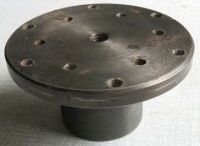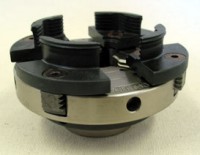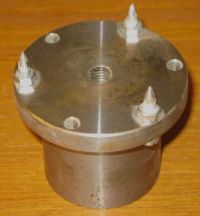| Main page | Læs denne side på dansk |

|
Techniques to mount the wood in the lathe
When a blank is to be turned, it has to be mounted in the lathe in some way. A device for holding the wood is often called a chuck. There are really many ways to mount the wood in the lathe and I will here describe the most common and useful.Mounting between centres
 This is the most used technique for mounting long pieces of wood for spindle turning. The drive centre (photo right) has spurs that are driven into the wood. It is usually mounted in the morse taper of the lathe spindle. The tailstock end is supported by a conical centre also driven into the centre of the wood or simply fitted into a pre-drilled hole in the wood. The tailstock centre may be fixed or it may be a live centre with ball bearings that allows it to rotate with the blank.
This is the most used technique for mounting long pieces of wood for spindle turning. The drive centre (photo right) has spurs that are driven into the wood. It is usually mounted in the morse taper of the lathe spindle. The tailstock end is supported by a conical centre also driven into the centre of the wood or simply fitted into a pre-drilled hole in the wood. The tailstock centre may be fixed or it may be a live centre with ball bearings that allows it to rotate with the blank.
Mounting on a faceplate
 Wide blanks like bowl blanks may be mounted on a faceplate. A faceplate is a metal disc, usually with a thread so that it can be screewed onto the lathe spindle. In the plate there are holes for screwing the blank to the faceplate. The plate and screws doesn't allow cutting on a large part of the blank and it leaves screw holes in the wood. Faceplate mounting is, therefore, usually followed by another mounting technique where the other side of the blank can be turned.
Wide blanks like bowl blanks may be mounted on a faceplate. A faceplate is a metal disc, usually with a thread so that it can be screewed onto the lathe spindle. In the plate there are holes for screwing the blank to the faceplate. The plate and screws doesn't allow cutting on a large part of the blank and it leaves screw holes in the wood. Faceplate mounting is, therefore, usually followed by another mounting technique where the other side of the blank can be turned.
Often, faceplates have only three holes for the screws to mount the wood. Then it is an advantage to drill more holes both near the rim and closer to the centre to allow the use of more screws / shorter screws.
Scroll chucks
 The scroll chuck is an expensive but very useful acessory for the lathe. It has three or four jaws that can be tightened to clamp the wood. Most scroll chucks can hold square blanks so that it isn't necessary to turn the blank round before mounting in the scroll chuck.
The scroll chuck is an expensive but very useful acessory for the lathe. It has three or four jaws that can be tightened to clamp the wood. Most scroll chucks can hold square blanks so that it isn't necessary to turn the blank round before mounting in the scroll chuck.
For most scroll chucks you can buy a number of different jaw sets to fit diffent sizes and ahapes of wood. You often can buy large flat jaws (often called 'Jumbo jaws') that can grip on the rim of a bowl so that the bottom of an almost finished bowl can be turned. They usually have rubber pieces for gripping the rim of the bowl to prevent making marks on the bowl.
Mounting with a screw chuck
A screw chuck simply has a wood screw that is screwed into the wood for holidng it. The screw can be held by a small piece of wood that is held in the lathe in another way, it can be tapered to fit the spindle's morse taper, screwed to a faceplate, held in a scroll chuck or the wood piece may have a thread fitting the thread on the lathe spindle.The pin chuck
The pin chuck is designed to hold irregular pieces of wood, for example a section of a trunk that has to be held from the bark side. The pin chuck needs a hole drilled in the wood. The pin chuck is a cylinder that fits in this hole. On a flat on the cylinder a small cylindrical roll is placed that locks the wood to the pin chuck when the lathe turns. To release the wood you simply rotate it the opposite way.Some other mounting techniques:
Mounting in the morse taper: The wood is turned, typically between centres, so that i has a conical end that fits into the headstock spindle morse taper. The wood is secured in the morse taper with a knock of a hammer.Jam chuck: usually used for finishing a partly turned object. A piece of wood is mounted on the lathe in some way and a hole or tenon is turned so that the object to be turned fits tightly on. The live centre in the tailstock is usually used to secure the mount. Otherwise, the object may be secured with adhesive tape.
Glue chuck: The item to be turned is glued to another piece of wood, that is mounted in the lathe. By having a sheet of paper glued inbetween the to pieces of wood, it is relatively simple to break them apart after turning by forcing a knife into the glue joint.
Foam coated disc: A bowl may be mounted on a flat plate mounted in the lathe by having a sheet of foam or rubber between the plate and the bowl and applying pressure from the live centre in the tailstock. The very inner part where the centre supports the bowl must be cut by hand.
 Giant spur drive: By screwing three screws with sharpened tips to a faceplate you can cheaply make your own giant spur drive for large pieces of wood.
Giant spur drive: By screwing three screws with sharpened tips to a faceplate you can cheaply make your own giant spur drive for large pieces of wood.
There are many more mounting methods and devices, that are sold or can be made from wood or metal. |
Go on to 'How to use the different tools'
Back to 'Introduction to basic woodturning techniques'
Main page
Back to 'Introduction to basic woodturning techniques'
Main page
| Search this site: |